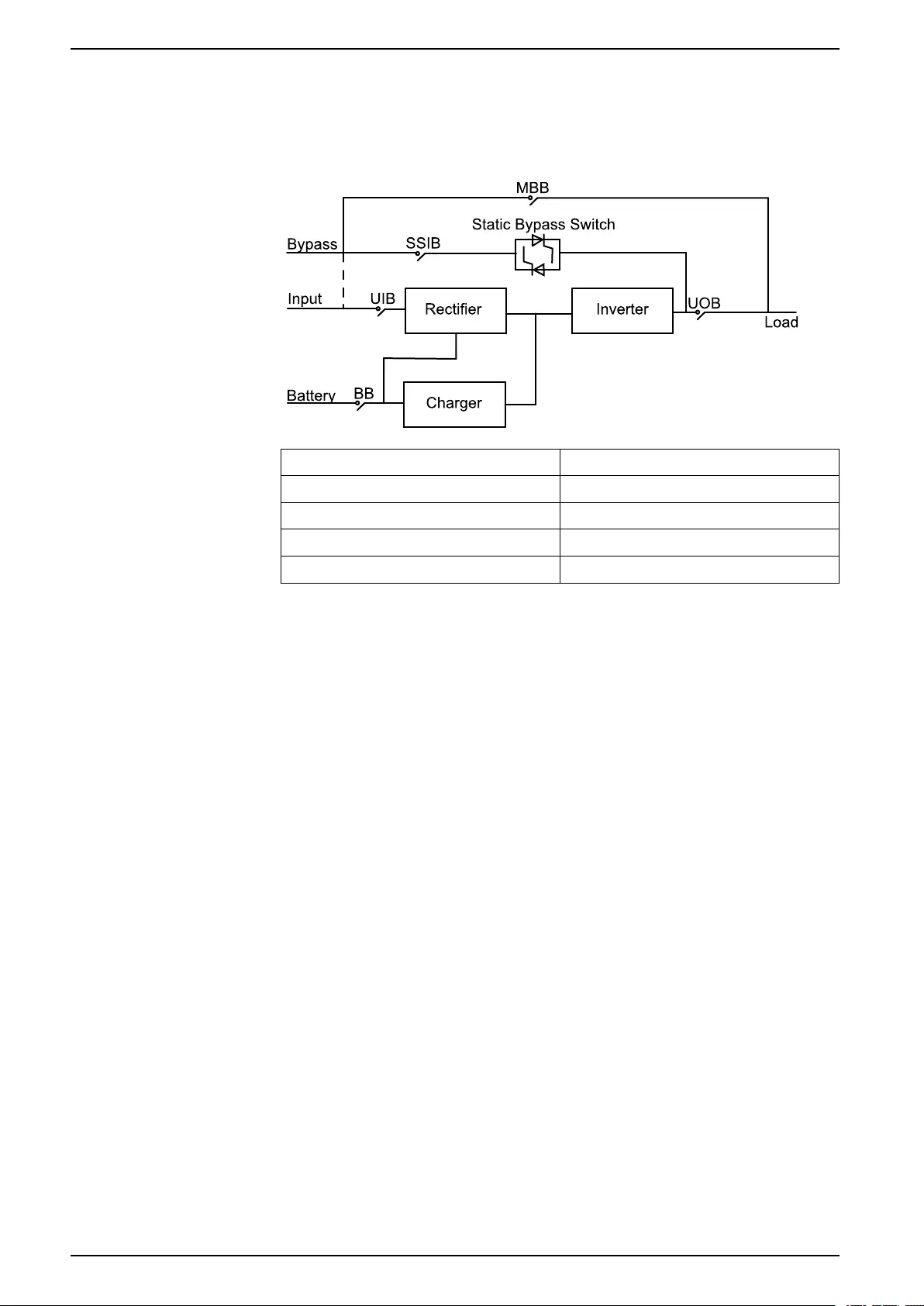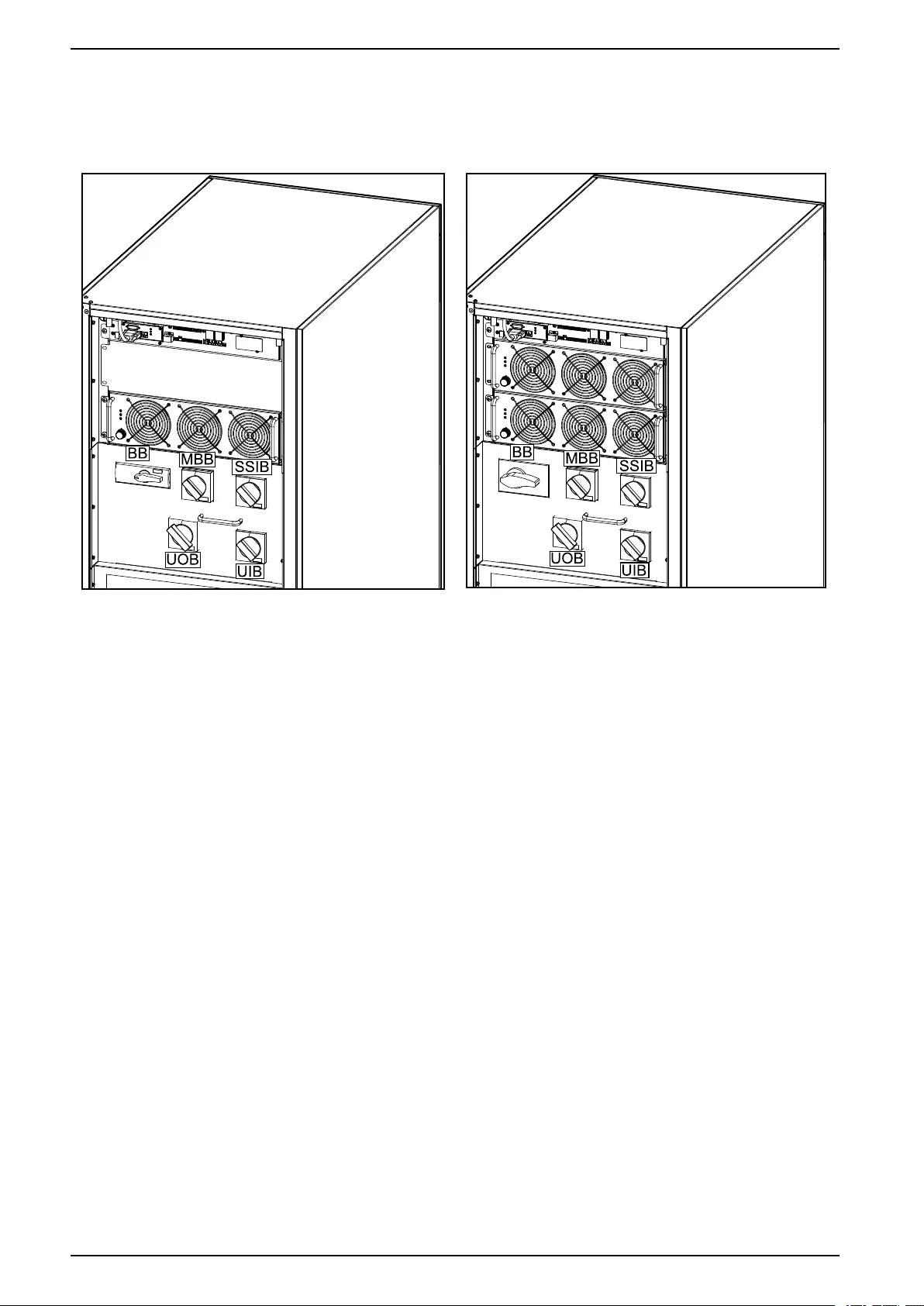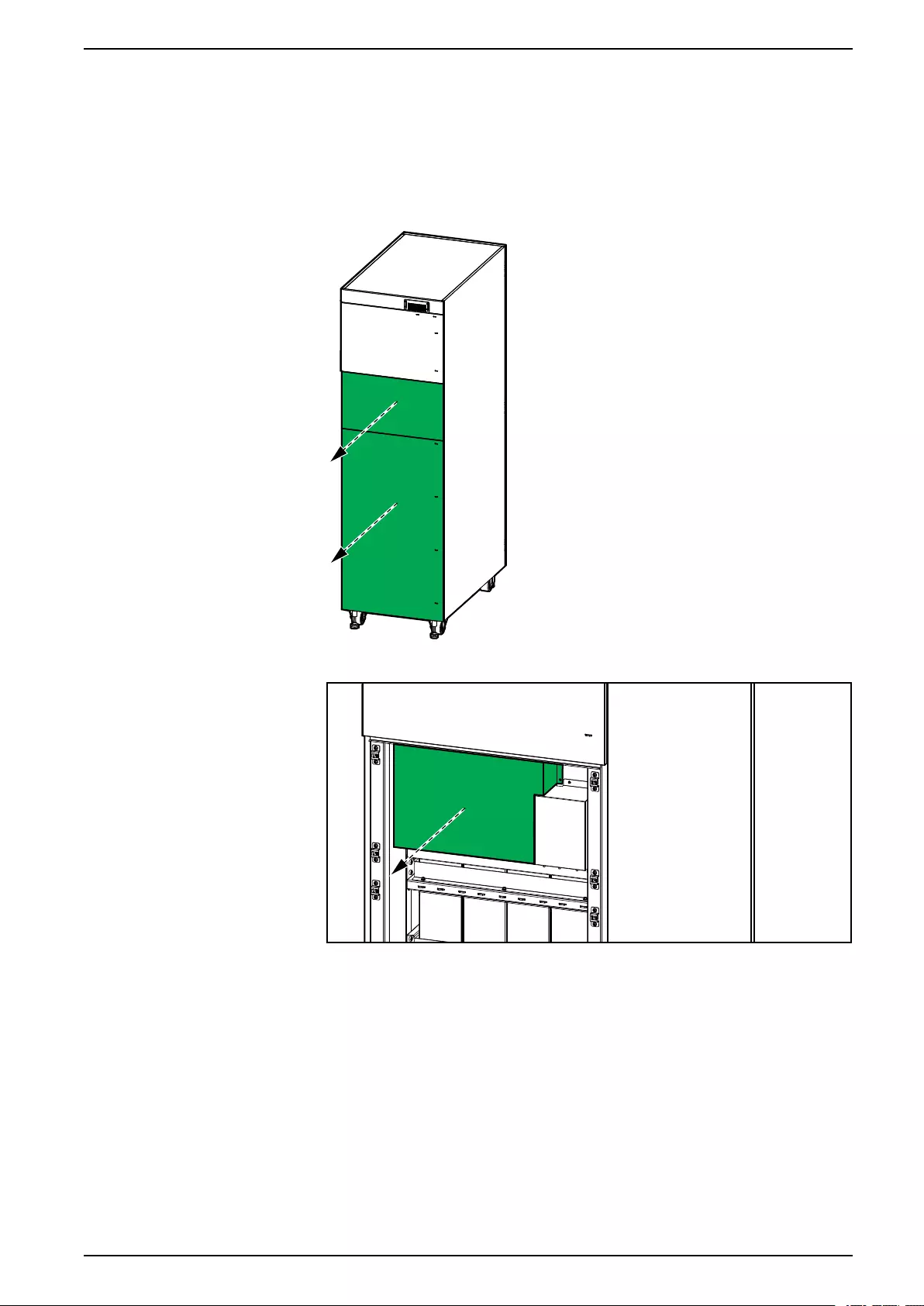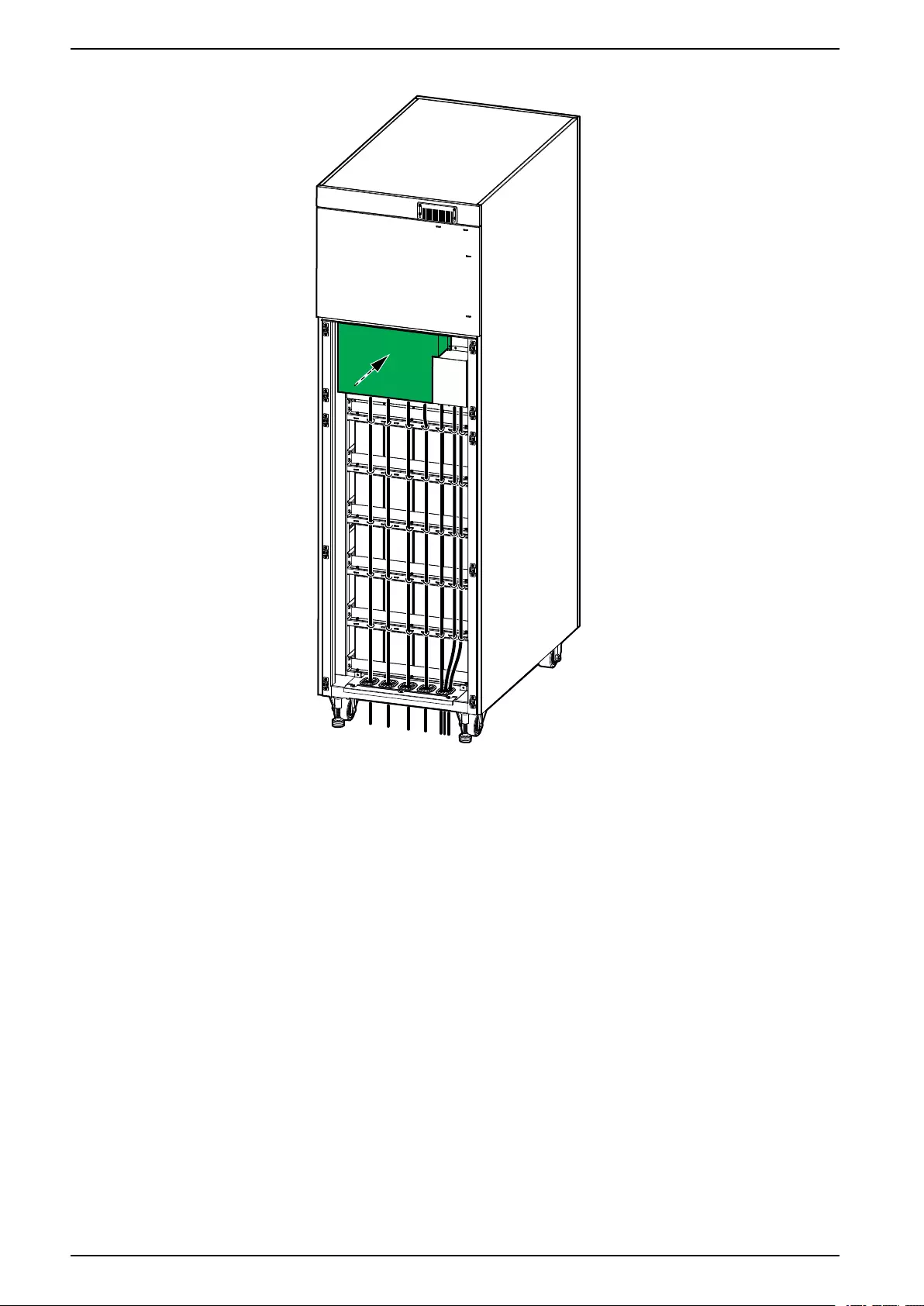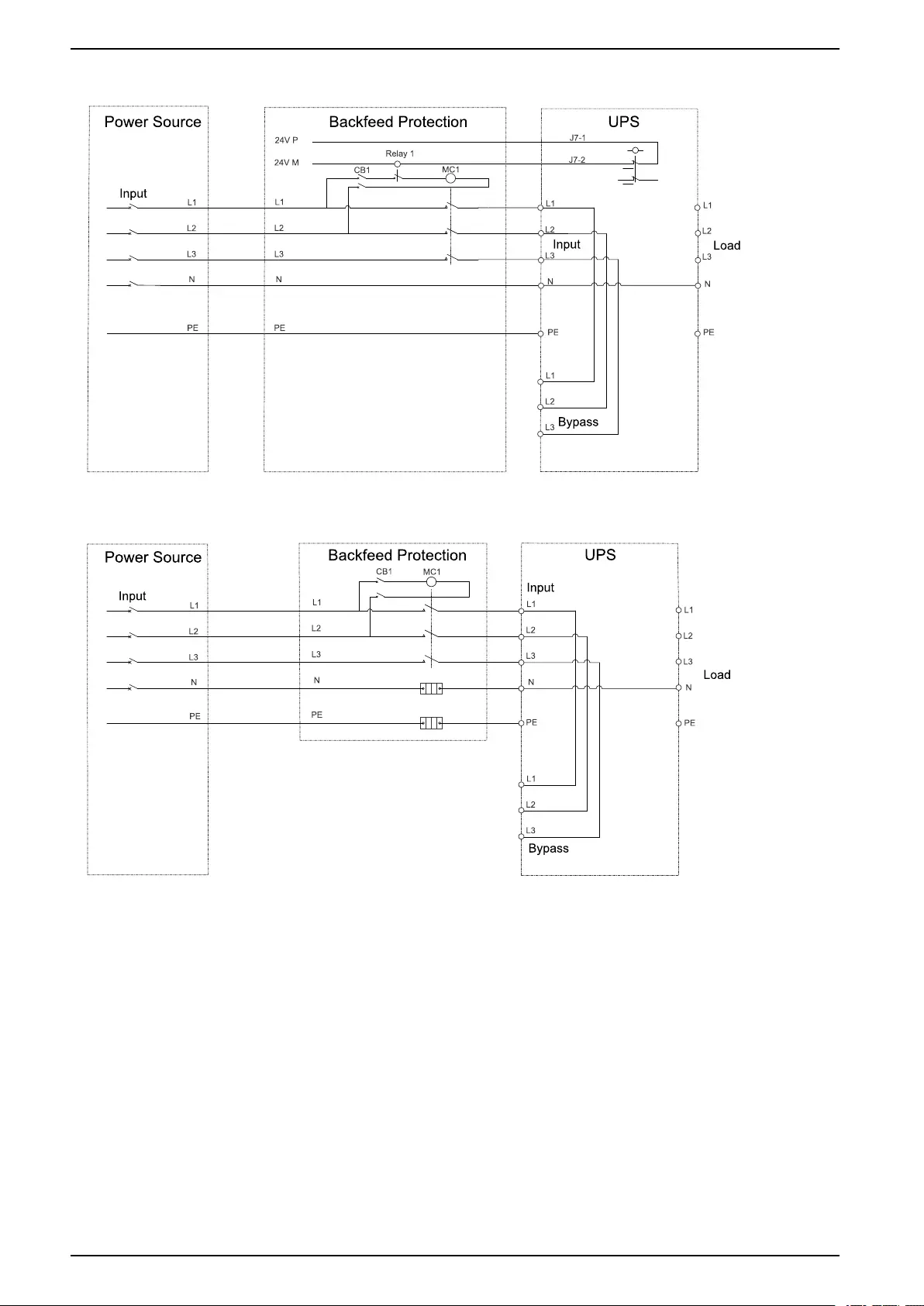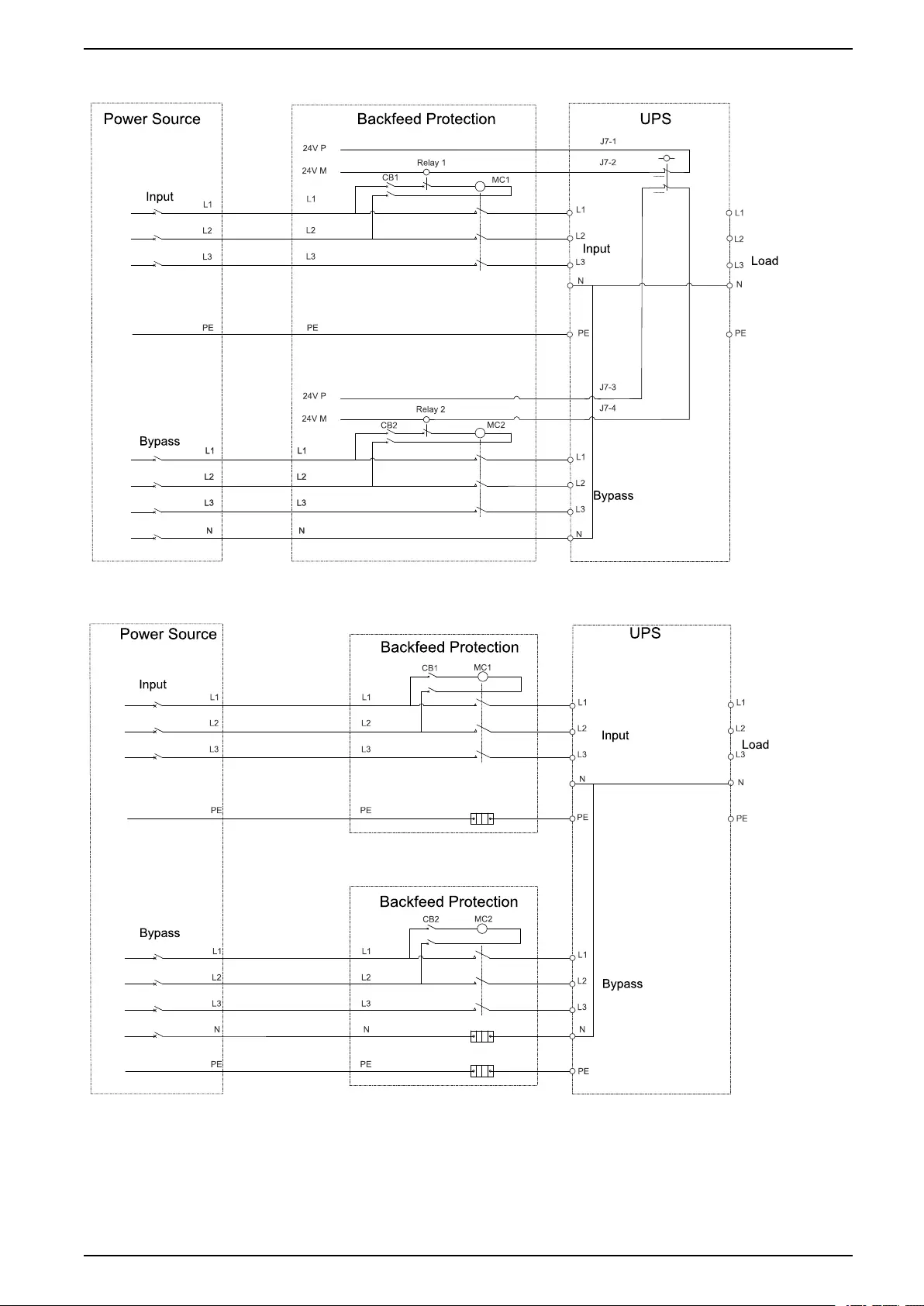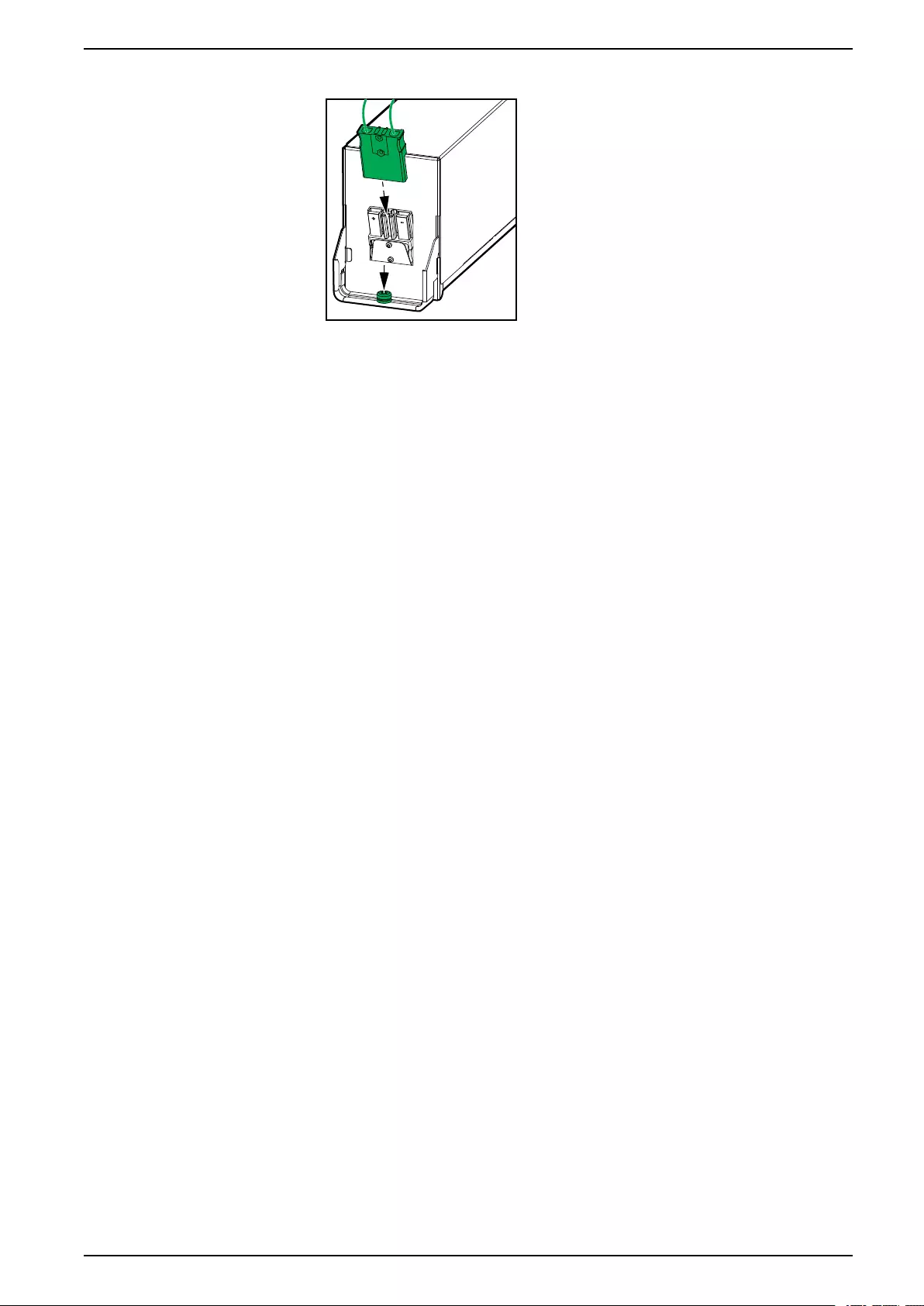Table of Contents
APC E3MUPS80KHBS User Manual
Displayed below is the user manual for E3MUPS80KHBS by APC which is a product in the Uninterruptible Power Supplies (UPSs) category. This manual has pages.
Related Manuals
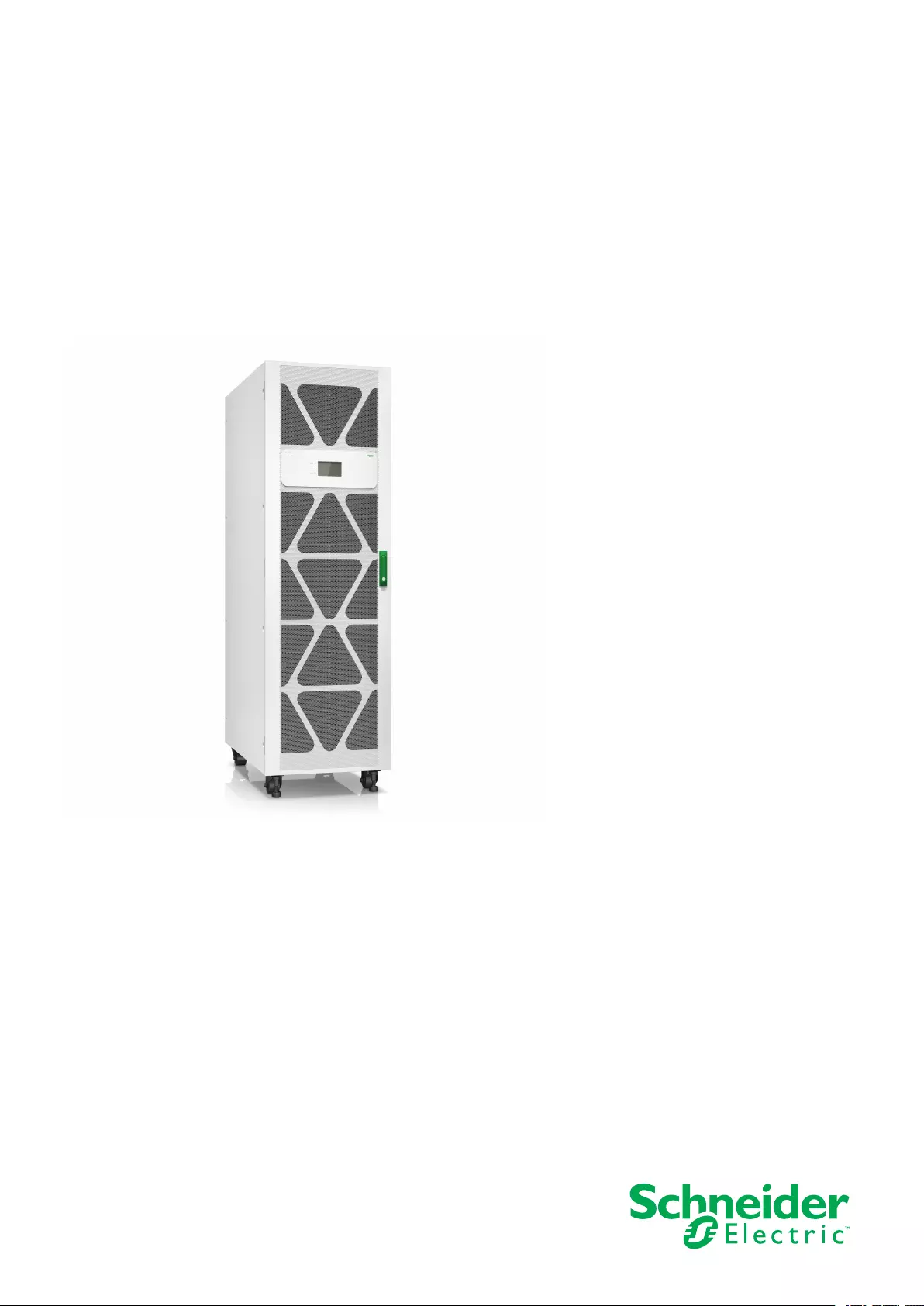
Easy UPS 3M
For Internal Batteries
Installation
60-80 kVA 400 V
09/2019
www.schneider-electric.com

Legal Information
The Schneider Electric brand and any trademarks of Schneider Electric SE and its
subsidiaries referred to in this guide are the property of Schneider Electric SE or its
subsidiaries. All other brands may be trademarks of their respective owners.
This guide and its content are protected under applicable copyright laws and
furnished for informational use only. No part of this guide may be reproduced or
transmitted in any form or by any means (electronic, mechanical, photocopying,
recording, or otherwise), for any purpose, without the prior written permission of
Schneider Electric.
Schneider Electric does not grant any right or license for commercial use of the guide
or its content, except for a non-exclusive and personal license to consult it on an "as
is" basis. Schneider Electric products and equipment should be installed, operated,
serviced, and maintained only by qualified personnel.
As standards, specifications, and designs change from time to time, information
contained in this guide may be subject to change without notice.
To the extent permitted by applicable law, no responsibility or liability is assumed by
Schneider Electric and its subsidiaries for any errors or omissions in the informational
content of this material or consequences arising out of or resulting from the use of the
information contained herein.

For Internal Batteries
Table of Contents
Important Safety Instructions — SAVE THESE
INSTRUCTIONS.........................................................................................5
Electromagnetic Compatibility .....................................................................6
Safety Precautions .....................................................................................6
Electrical Safety....................................................................................8
Battery Safety.......................................................................................9
Specifications ............................................................................................ 11
Input Specifications .................................................................................. 11
Bypass Specifications ............................................................................... 11
Output Specifications................................................................................ 11
Battery Specifications ...............................................................................12
Recommended Upstream Protection..........................................................12
Recommended Cables Sizes ....................................................................13
Recommended Bolts and Cable Lugs ........................................................13
Torque Specifications................................................................................14
UPS Weights and Dimensions...................................................................14
Clearance ................................................................................................14
Environmental ..........................................................................................15
Heat Dissipation .................................................................................15
Overview ....................................................................................................16
Overview of Single UPS ............................................................................16
Overview of Parallel System......................................................................17
Location of Breakers.................................................................................18
Connect the Power Cables......................................................................19
Communication Interfaces.......................................................................23
Route the Signal Cables............................................................................23
Input Contacts and Output Relays..............................................................25
Connect the Parallel Cables in a Parallel System ........................................28
Backfeed Protection .................................................................................29
Install Batteries in the UPS......................................................................32
990-6204-001 3

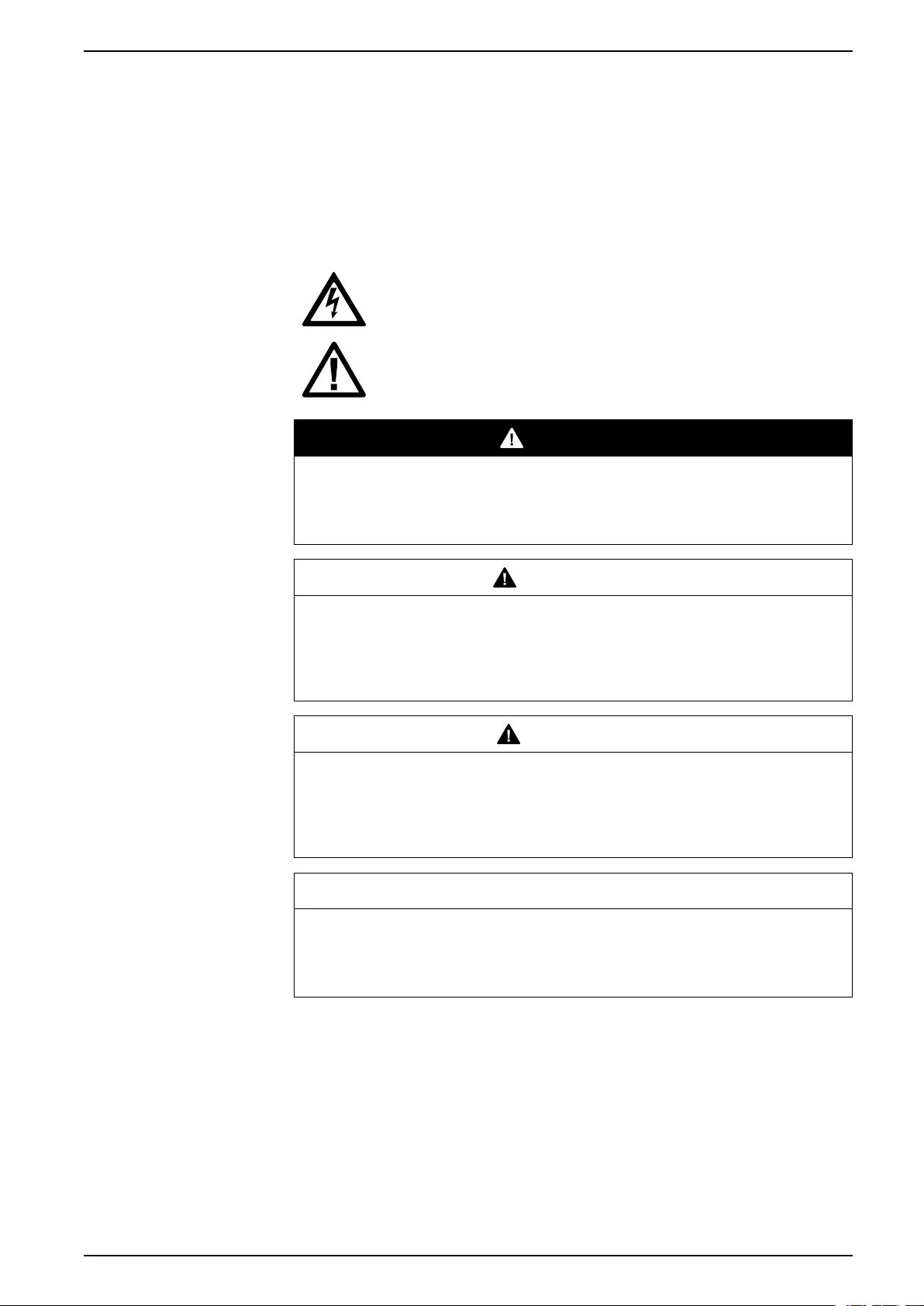
Important Safety Instructions — SAVE THESE
INSTRUCTIONS For Internal Batteries
Important Safety Instructions — SAVE THESE
INSTRUCTIONS
Read these instructions carefully and look at the equipment to become familiar
with it before trying to install, operate, service or maintain it. The following safety
messages may appear throughout this manual or on the equipment to warn of
potential hazards or to call attention to information that clarifies or simplifies a
procedure.
The addition of this symbol to a “Danger” or “Warning” safety
message indicates that an electrical hazard exists which will result in
personal injury if the instructions are not followed.
This is the safety alert symbol. It is used to alert you to potential
personal injury hazards. Obey all safety messages with this symbol
to avoid possible injury or death.
DANGER
DANGER indicates a hazardous situation which, if not avoided, will result in
death or serious injury.
Failure to follow these instructions will result in death or serious injury.
WARNING
WARNING indicates a hazardous situation which, if not avoided, could result
in death or serious injury.
Failure to follow these instructions can result in death, serious injury, or
equipment damage.
CAUTION
CAUTION indicates a hazardous situation which, if not avoided, could result in
minor or moderate injury.
Failure to follow these instructions can result in injury or equipment
damage.
NOTICE
NOTICE is used to address practices not related to physical injury. The safety
alert symbol shall not be used with this type of safety message.
Failure to follow these instructions can result in equipment damage.
Please Note
Electrical equipment should only be installed, operated, serviced, and maintained
by qualified personnel. No responsibility is assumed by Schneider Electric for any
consequences arising out of the use of this material.
A qualified person is one who has skills and knowledge related to the construction,
installation, and operation of electrical equipment and has received safety training
to recognize and avoid the hazards involved.
990-6204-001 5
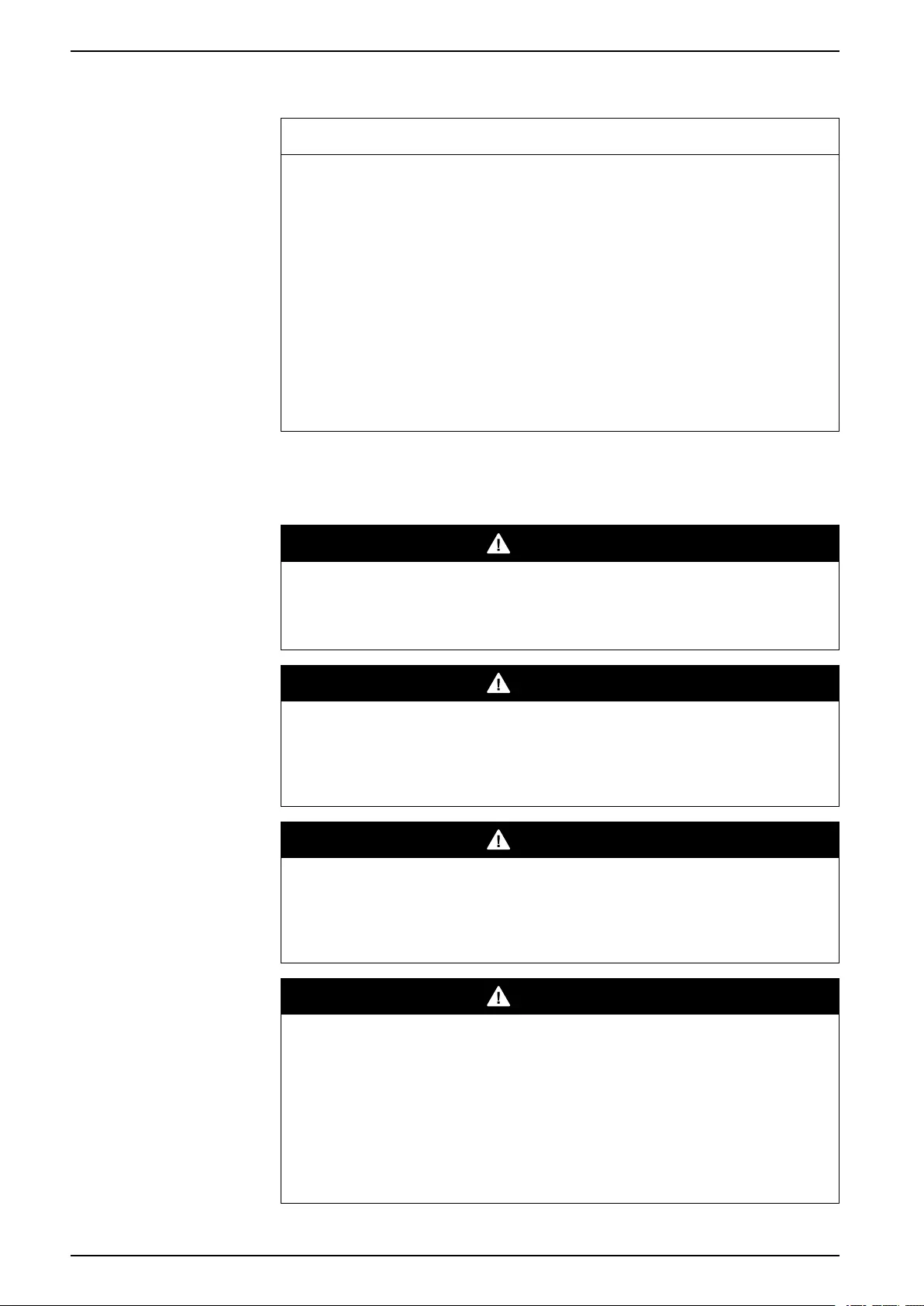
For Internal Batteries
Important Safety Instructions — SAVE THESE
INSTRUCTIONS
Electromagnetic Compatibility
NOTICE
RISK OF ELECTROMAGNETIC DISTURBANCE
This is a product Category C3 according to IEC 62040-2. This is a product for
commercial and industrial applications in the second environment - installation
restrictions or additional measures may be needed to prevent disturbances. The
second environment includes all commercial, light industry, and industrial
locations other than residential, commercial, and light industrial premises
directly connected without intermediate transformer to a public low-voltage
mains supply. The installation and cabling must follow the electromagnetic
compatibility rules, e.g.:
• the segregation of cables,
• the use of shielded or special cables when relevant,
• the use of grounded metallic cable tray and supports.
Failure to follow these instructions can result in equipment damage.
Safety Precautions
DANGER
HAZARD OF ELECTRIC SHOCK, EXPLOSION, OR ARC FLASH
All safety instructions in this document must be read, understood and followed.
Failure to follow these instructions will result in death or serious injury.
DANGER
HAZARD OF ELECTRIC SHOCK, EXPLOSION, OR ARC FLASH
Read all instructions in the Installation Manual before installing or working on
this UPS system.
Failure to follow these instructions will result in death or serious injury.
DANGER
HAZARD OF ELECTRIC SHOCK, EXPLOSION, OR ARC FLASH
Do not install the UPS system until all construction work has been completed
and the installation room has been cleaned.
Failure to follow these instructions will result in death or serious injury.
DANGER
HAZARD OF ELECTRIC SHOCK, EXPLOSION, OR ARC FLASH
• The product must be installed according to the specifications and
requirements as defined by Schneider Electric. It concerns in particular the
external and internal protections (upstream breakers, battery breakers,
cabling, etc.) and environmental requirements. No responsibility is assumed
by Schneider Electric if these requirements are not respected.
• After the UPS system has been electrically wired, do not start up the system.
Start-up must only be performed by Schneider Electric.
Failure to follow these instructions will result in death or serious injury.
6 990-6204-001
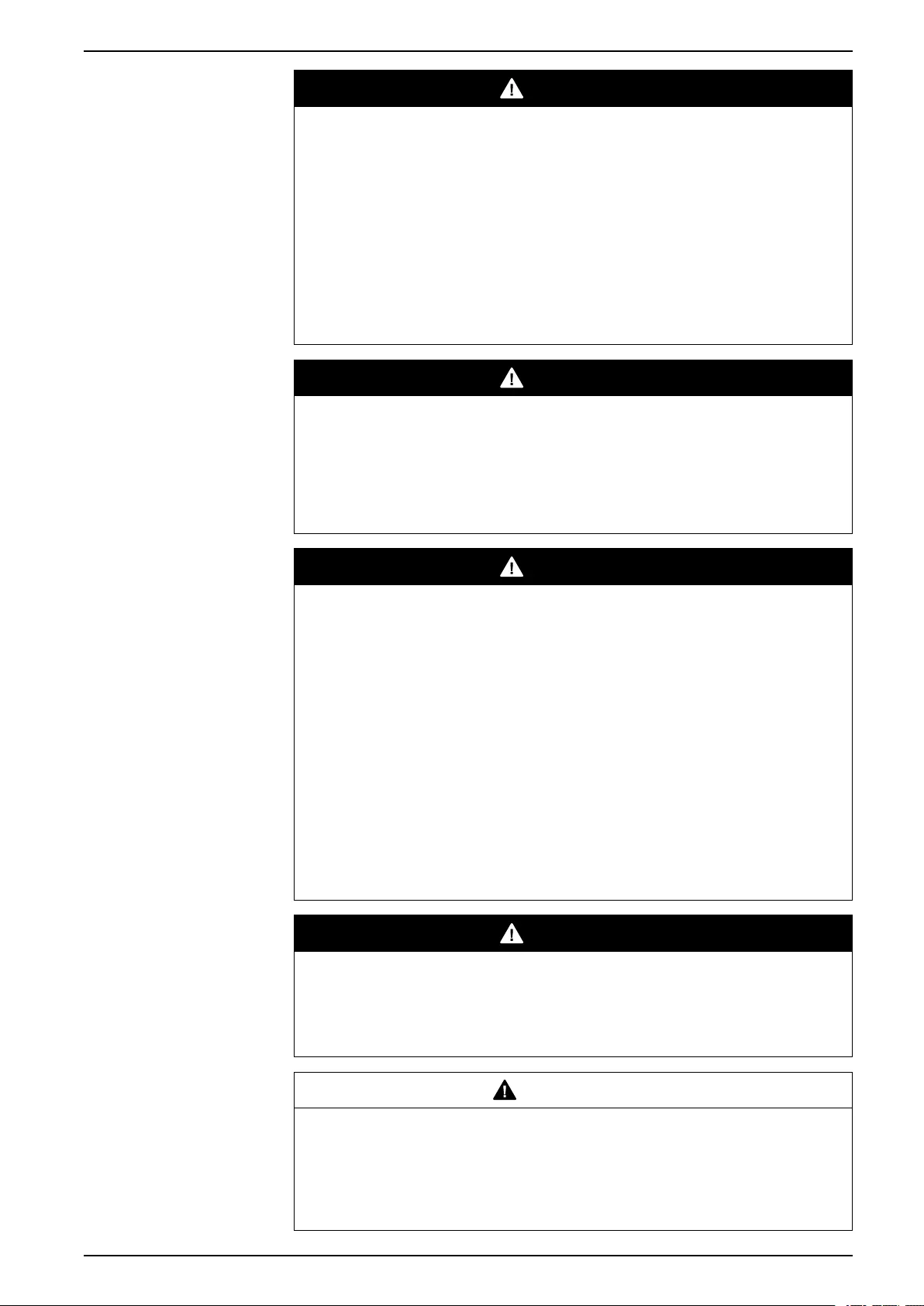
Important Safety Instructions — SAVE THESE
INSTRUCTIONS For Internal Batteries
DANGER
HAZARD OF ELECTRIC SHOCK, EXPLOSION, OR ARC FLASH
The UPS system must be installed according to local and national regulations.
Install the UPS according to:
• IEC 60364 (including 60364–4–41- protection against electric shock, 60364–
4–42 - protection against thermal effect, and 60364–4–43 - protection
against overcurrent), or
• NEC NFPA 70, or
• Canadian Electrical Code (C22.1, Part 1)
depending on which one of the standards apply in your local area.
Failure to follow these instructions will result in death or serious injury.
DANGER
HAZARD OF ELECTRIC SHOCK, EXPLOSION, OR ARC FLASH
• Install the UPS system in a temperature controlled indoor environment free
of conductive contaminants and humidity.
• Install the UPS system on a non-flammable, level and solid surface (e.g.
concrete) that can support the weight of the system.
Failure to follow these instructions will result in death or serious injury.
DANGER
HAZARD OF ELECTRIC SHOCK, EXPLOSION, OR ARC FLASH
The UPS is not designed for and must therefore not be installed in the following
unusual operating environments:
• Damaging fumes
• Explosive mixtures of dust or gases, corrosive gases, or conductive or
radiant heat from other sources
• Moisture, abrasive dust, steam or in an excessively damp environment
• Fungus, insects, vermin
• Salt-laden air or contaminated cooling refrigerant
• Pollution degree higher than 2 according to IEC 60664-1
• Exposure to abnormal vibrations, shocks, and tilting
• Exposure to direct sunlight, heat sources, or strong electromagnetic fields
Failure to follow these instructions will result in death or serious injury.
DANGER
HAZARD OF ELECTRIC SHOCK, EXPLOSION, OR ARC FLASH
Do not drill or cut holes for cables or conduits with the gland plates installed and
do not drill or cut holes in close proximity to the UPS.
Failure to follow these instructions will result in death or serious injury.
WARNING
HAZARD OF ARC FLASH
Do not make mechanical changes to the product (including removal of cabinet
parts or drilling/cutting of holes) that are not described in the Installation Manual.
Failure to follow these instructions can result in death, serious injury, or
equipment damage.
990-6204-001 7
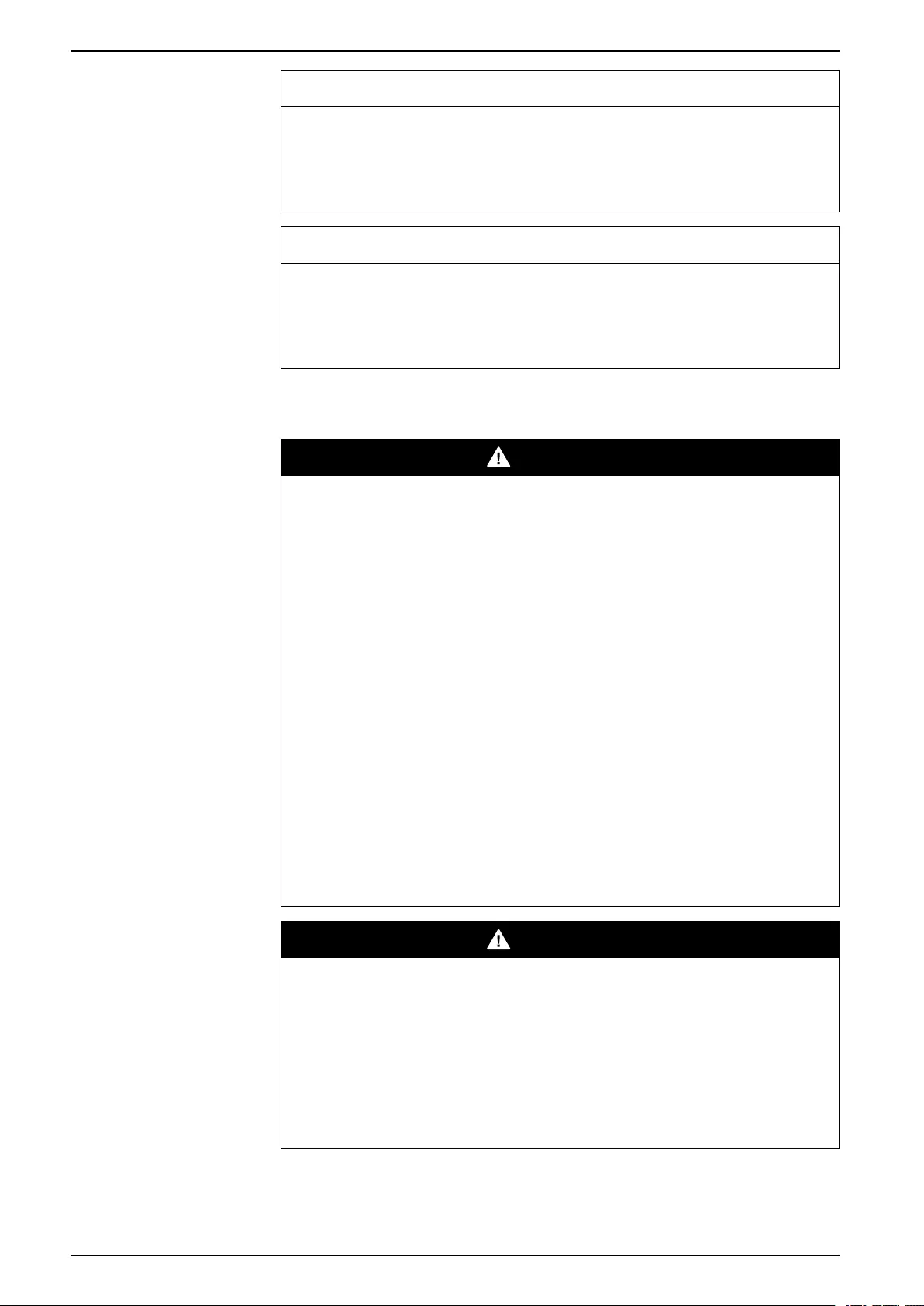
For Internal Batteries
Important Safety Instructions — SAVE THESE
INSTRUCTIONS
NOTICE
RISK OF OVERHEATING
Respect the space requirements around the UPS system and do not cover the
product’s ventilation openings when the UPS system is in operation.
Failure to follow these instructions can result in equipment damage.
NOTICE
RISK OF EQUIPMENT DAMAGE
Do not connect the UPS output to regenerative load systems including
photovoltaic systems and speed drives.
Failure to follow these instructions can result in equipment damage.
Electrical Safety
DANGER
HAZARD OF ELECTRIC SHOCK, EXPLOSION, OR ARC FLASH
• Electrical equipment must be installed, operated, serviced, and maintained
only by qualified personnel.
• Apply appropriate personal protective equipment (PPE) and follow safe
electrical work practices.
• Turn off all power supplying the UPS system before working on or inside the
equipment.
• Before working on the UPS system, check for hazardous voltage between all
terminals including the protective earth.
• The UPS contains an internal energy source. Hazardous voltage can be
present even when disconnected from the mains supply. Before installing or
servicing the UPS system, ensure that the units are OFF and that mains and
batteries are disconnected. Wait five minutes before opening the UPS to
allow the capacitors to discharge.
• A disconnection device (e.g. disconnection circuit breaker or switch) must be
installed to enable isolation of the system from upstream power sources in
accordance with local regulations. The disconnection device must be easily
accessible and visible.
• The UPS must be properly earthed/grounded and due to a high leakage
current, the earthing/grounding conductor must be connected first.
Failure to follow these instructions will result in death or serious injury.
DANGER
HAZARD OF ELECTRIC SHOCK, EXPLOSION, OR ARC FLASH
In systems where backfeed protection is not part of the standard design, an
automatic isolation device (backfeed protection option or other device meeting
the requirements of IEC/EN 62040–1 or UL1778 5th Edition – depending on
which of the two standards apply to your local area) must be installed to prevent
hazardous voltage or energy at the input terminals of the isolation device. The
device must open within 15 seconds after the upstream power supply fails and
must be rated according to the specifications.
Failure to follow these instructions will result in death or serious injury.
When the UPS input is connected through external isolators that, when opened,
isolate the neutral or when the automatic backfeed isolation is provided external to
the equipment or is connected to an IT power distribution system, a label must be
fitted at the UPS input terminals, and on all primary power isolators installed
8 990-6204-001

Important Safety Instructions — SAVE THESE
INSTRUCTIONS For Internal Batteries
remote from the UPS area and on external access points between such isolators
and the UPS, by the user, displaying the following text (or equivalent in a language
which is acceptable in the country in which the UPS system is installed):
DANGER
HAZARD OF ELECTRIC SHOCK, EXPLOSION, OR ARC FLASH
Risk of Voltage Backfeed. Before working on this circuit: Isolate the UPS and
check for hazardous voltage between all terminals including the protective
earth.
Failure to follow these instructions will result in death or serious injury.
Battery Safety
DANGER
HAZARD OF ELECTRIC SHOCK, EXPLOSION, OR ARC FLASH
• Battery circuit breakers must be installed according to the specifications and
requirements as defined by Schneider Electric.
• Servicing of batteries must only be performed or supervised by qualified
personnel knowledgeable of batteries and the required precautions. Keep
unqualified personnel away from batteries.
• Disconnect charging source prior to connecting or disconnecting battery
terminals.
• Do not dispose of batteries in a fire as they can explode.
• Do not open, alter, or mutilate batteries. Released electrolyte is harmful to
the skin and eyes. It may be toxic.
Failure to follow these instructions will result in death or serious injury.
DANGER
HAZARD OF ELECTRIC SHOCK, EXPLOSION, OR ARC FLASH
Batteries can present a risk of electric shock and high short-circuit current. The
following precautions must be observed when working on batteries
• Remove watches, rings, or other metal objects.
• Use tools with insulated handles.
• Wear protective glasses, gloves and boots.
• Do not lay tools or metal parts on top of batteries.
• Disconnect the charging source prior to connecting or disconnecting battery
terminals.
• Determine if the battery is inadvertently grounded. If inadvertently grounded,
remove source from ground. Contact with any part of a grounded battery can
result in electric shock. The likelihood of such shock can be reduced if such
grounds are removed during installation and maintenance (applicable to
equipment and remote battery supplies not having a grounded supply
circuit).
Failure to follow these instructions will result in death or serious injury.
DANGER
HAZARD OF ELECTRIC SHOCK, EXPLOSION, OR ARC FLASH
When replacing batteries, always replace with the same type and number of
batteries or battery packs.
Failure to follow these instructions will result in death or serious injury.
990-6204-001 9

For Internal Batteries
Important Safety Instructions — SAVE THESE
INSTRUCTIONS
NOTICE
RISK OF EQUIPMENT DAMAGE
• Wait until the system is ready to be powered up before installing batteries in
the system. The time duration from battery installation until the UPS system
is powered up must not exceed 72 hours or 3 days.
• Batteries must not be stored more than six months due to the requirement of
recharging. If the UPS system remains de-energized for a long period,
Schneider Electric recommends that you energize the UPS system for a
period of 24 hours at least once every month. This charges the batteries,
thus avoiding irreversible damage.
Failure to follow these instructions can result in equipment damage.
10 990-6204-001

Specifications For Internal Batteries
Specifications
Input Specifications
60 kVA 80 kVA
Voltage (V) 380 400 415 380 400 415
Connections L1, L2, L3, N, PE
Input voltage range (V) 342–477 at full load1
Frequency range (Hz) 40–70
Nominal input current (A) 96 91 88 128 122 117
Maximum input current (A) 109 104 100 154 146 141
Input current limitation (A) 155 206
Total harmonic distortion (THDI) <3% for linear loads
Input power factor > 0.99
Maximum short circuit rating 10 kA RMS
Protection Fuse
Ramp-in 7 seconds
Bypass Specifications
60 kVA 80 kVA
Voltage (V) 380 400 415 380 400 415
Connections L1, L2, L3, N, PE
Overload capacity 110% for 60 minutes
130% for 10 minutes
130–150% for 1 minute
Minimum bypass voltage (V) 266 280 291 266 280 291
Maximum bypass voltage (V) 475 480 477 475 480 477
Frequency (Hz) 50 or 60
Frequency range (%) ±1, ±2, ±4, ±5, ±10. Default is ±10 (user
selectable).
Nominal bypass current (A) 91 87 83 122 115 111
Maximum short circuit rating 10 kA RMS
Output Specifications
60 kVA 80 kVA
Voltage (V) 380 400 415 380 400 415
Connections L1, L2, L3, N, PE
Overload capacity2110% for 60 minutes
125% for 10 minutes
150% for 1 minute
Output voltage regulation ± 1%
990-6204-001 11
1. 150–342 V with a linear derating of the load to 30%.
2. At 30 °C.

For Internal Batteries Specifications
60 kVA 80 kVA
Voltage (V) 380 400 415 380 400 415
Dynamic load response 20 milliseconds
Output power factor 1.0
Nominal output current (A) 91 87 83 122 115 111
Total harmonic distortion (THDU) <3% at 100% linear load
<5% at 100% non-linear load
Output frequency (Hz) 50 or 60
Slew rate (Hz/sec) Programmable: 0.5 to 2.0. Default is 0.5
Output performance classification (according to IEC/ EN62040-3) VFI-SS–111
Load power factor 0.5 leading to 0.5 lagging without
derating
Battery Specifications
60 kVA 80 kVA
Charging power in % of output power 1–16% 1–24%
Maximum charging power (kW) 9600 19200
Nominal battery voltage (40 blocks) (VDC) ± 240
Nominal float voltage (40 blocks) (VDC) ± 270
End of discharge voltage (40 blocks) (VDC) ± 192
Battery current at full load and nominal battery voltage (A) 133 176
Battery current at full load and minimum battery voltage (A) 166 222
Temperature compensation (per cell) Programmable from 0–7 mV. Default is 0
mV
Ripple current < 5% C10
Recommended Upstream Protection
NOTE: For local directives which require 4–pole circuit breakers: If neutral
conductor is expected to carry a high current, due to line-neutral non-linear
load, the circuit breaker must be rated according to expected neutral current.
60 kVA 80 kVA
Input Bypass Input Bypass
Breaker type Compact NSX160F
TM125D (LV430631)
Compact NSX100F
TM100D (LV429630)
Compact NSX160F
TM160D (LV430630)
Compact NSX160F
TM160D (LV430630)
In setting 125 100 160 160
Ir setting 125 100 160 144
Im setting 800 (fixed) 800 (fixed) 1250 (fixed) 1250 (fixed)
12 990-6204-001

Specifications For Internal Batteries
Recommended Cables Sizes
DANGER
HAZARD OF ELECTRIC SHOCK, EXPLOSION, OR ARC FLASH
All wiring must comply with all applicable national and/or electrical codes. The
maximum allowable cable size is 50 mm².
Failure to follow these instructions will result in death or serious injury.
Cable sizes in this manual are based on table B.52.5 of IEC 60364–5–52 with the
following assertions:
• 90 °C conductors
• An ambient temperature of 30 °C
• Use of copper conductors
• Installation method C
PE size is based on table 54.2 of IEC 60364–4–54.
If the ambient temperature is greater than 30 °C, larger conductors are to be used
in accordance with the correction factors of the IEC.
60 kVA UPS
Cable Size per Phase (mm2) Neutral Cable Size (mm2)3PE Cable Size (mm2)
Input 35 2x25 16
Bypass 25 16
Output 25 2x25 16
Battery 50 50 25
80 kVA UPS
Cable Size per Phase (mm2) Neutral Cable Size (mm2)3PE Cable Size (mm2)
Input 50 2x50 25
Bypass 50 25
Output 50 2x50 25
Battery 2x50 2x50 50
Recommended Bolts and Cable Lugs
Cable Size (mm²) Bolt Size Cable Lug Type
16 M8 KST TLK16-8
25 M8 KST TLK25-8
35 M8 KST TLK35-8
50 M8 KST TLK50-8
990-6204-001 13
3. Neutral conductor is sized to handle 1.73 times phase current in case of high harmonic content from non-linear loads. If non or less
harmonic currents are expected, neutral conductor can be sized accordingly but not less than the phase conductor.
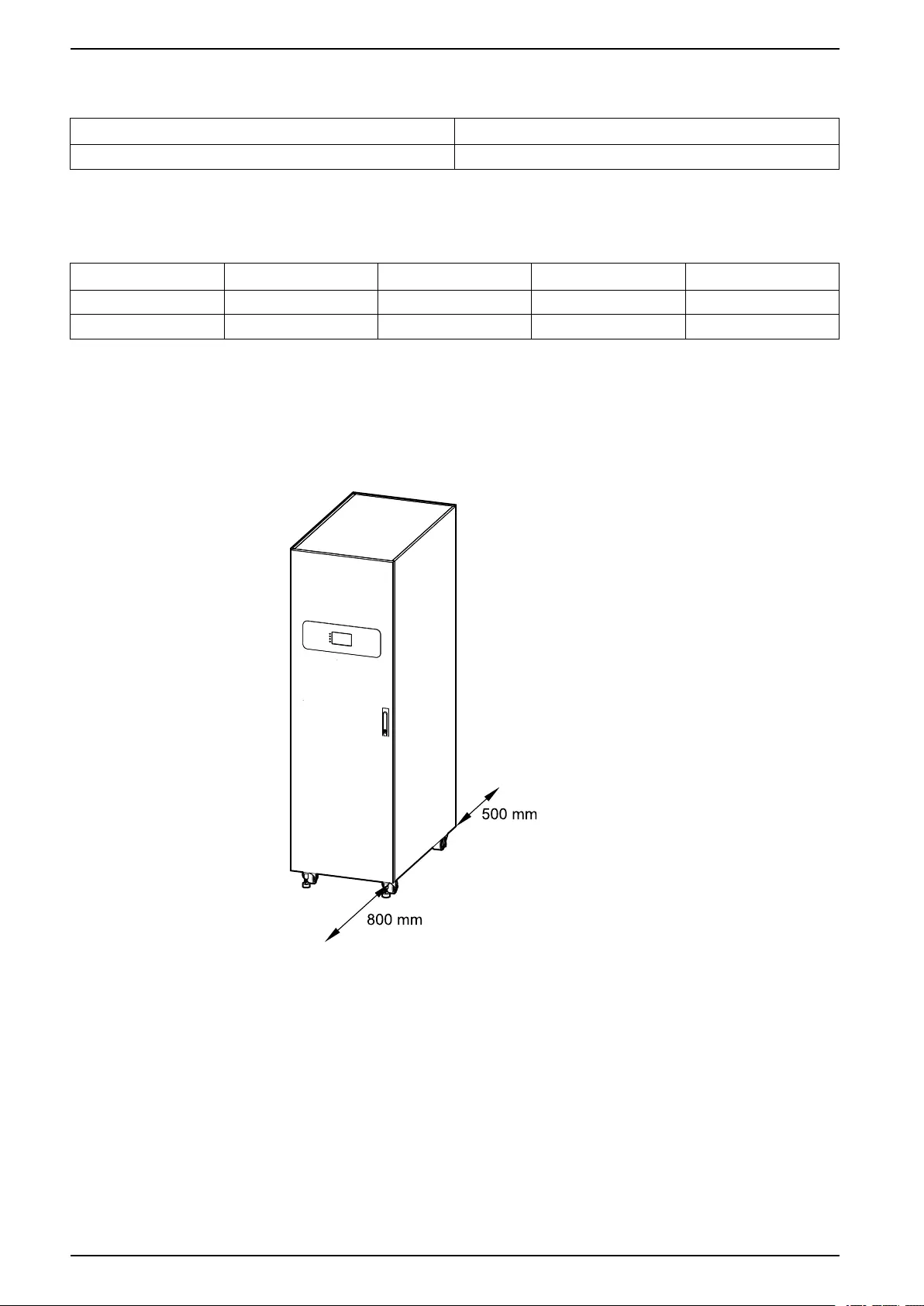
For Internal Batteries Specifications
Torque Specifications
Bolt Size Torque
M8 17.5 Nm
UPS Weights and Dimensions
UPS Weight kg Height mm Width mm Depth mm
60 kVA 311 1970 600 1000
80 kVA 339 1970 600 1000
Clearance
NOTE: Clearance dimensions are published for airflow and service access
only. Consult with the local safety codes and standards for additional
requirements in your local area.
14 990-6204-001

Specifications For Internal Batteries
Environmental
Operation Storage
Temperature 0 °C to 40 °C -15 °C to 40 °C for systems with batteries
-25 °C to 55 °C for systems without batteries
Relative humidity 0–95% non-condensing
Elevation derating according to
IEC 62040–3
Power derating factor:
0–1500 m: 1.000
1500–2000 m: 0.975
< 15000 m above sea level (or in an
environment with equivalent air pressure)
Audible noise <65 dBA at full load and an ambient
temperature of 30 °C4
Protection class IP20 (dust filter as standard)
Color RAL 9003
Heat Dissipation
60 kVA 80 kVA
W BTU/hr W BTU/hr
Normal operation 3084 10523 4296 14659
Battery operation 2958 10093 4352 14850
ECO mode 540 1843 696 2375
990-6204-001 15
4. According to ISO 3746.
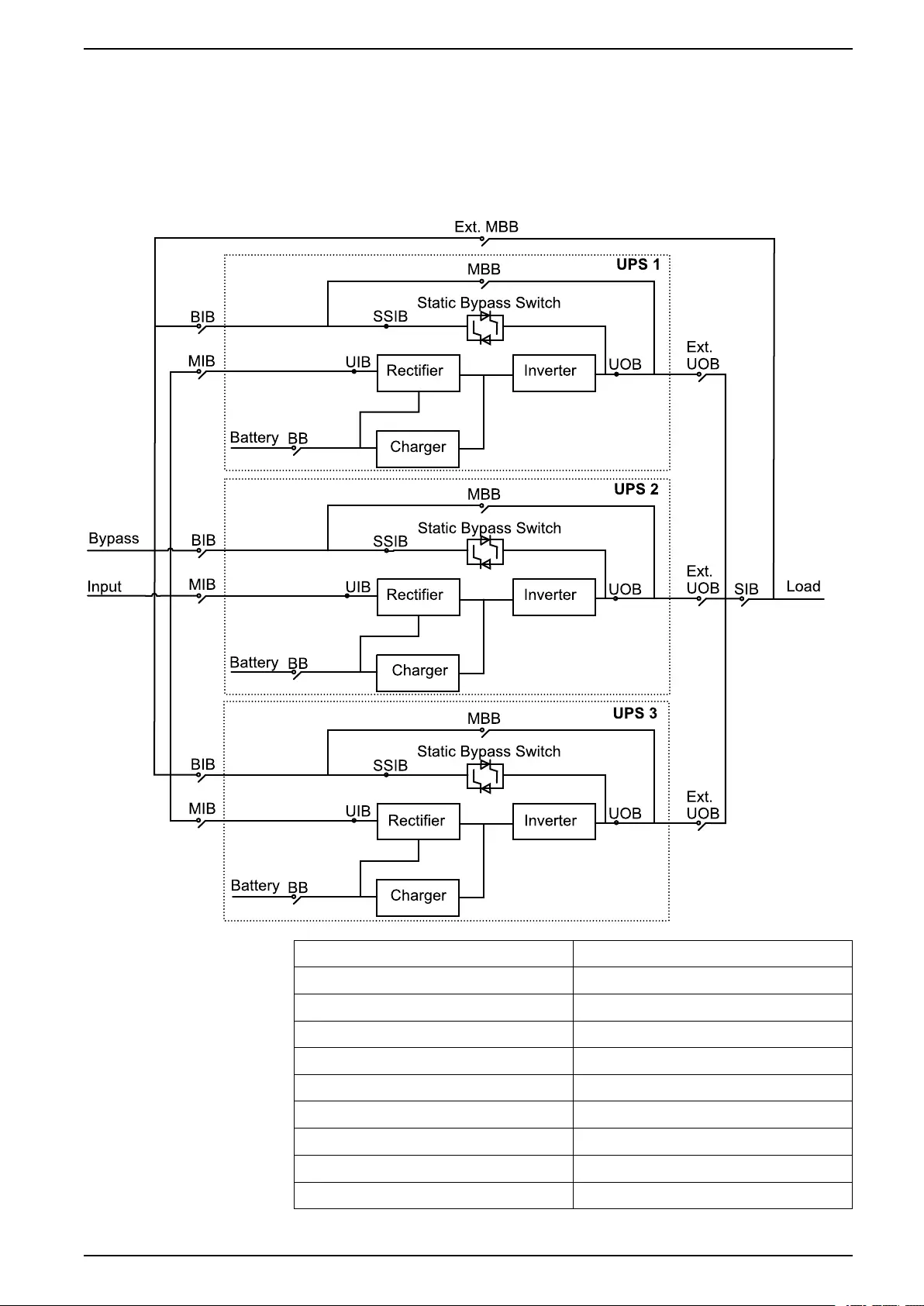
Overview For Internal Batteries
Overview of Parallel System
NOTE: In parallel systems with an external maintenance bypass breaker Ext.
MBB, the maintenance bypass breakers MBB must be padlocked in the open
position.
UPSs for Internal Batteries
MIB Mains input breaker
BIB Bypass input breaker
UIB Unit input breaker
SSIB Static switch input breaker
UOB Unit output breaker
Ext. UOB External unit output breaker
MBB Maintenance bypass breaker
Ext. MBB External maintenance bypass breaker
SIB System isolation breaker
BB Battery breaker
990-6204-001 17
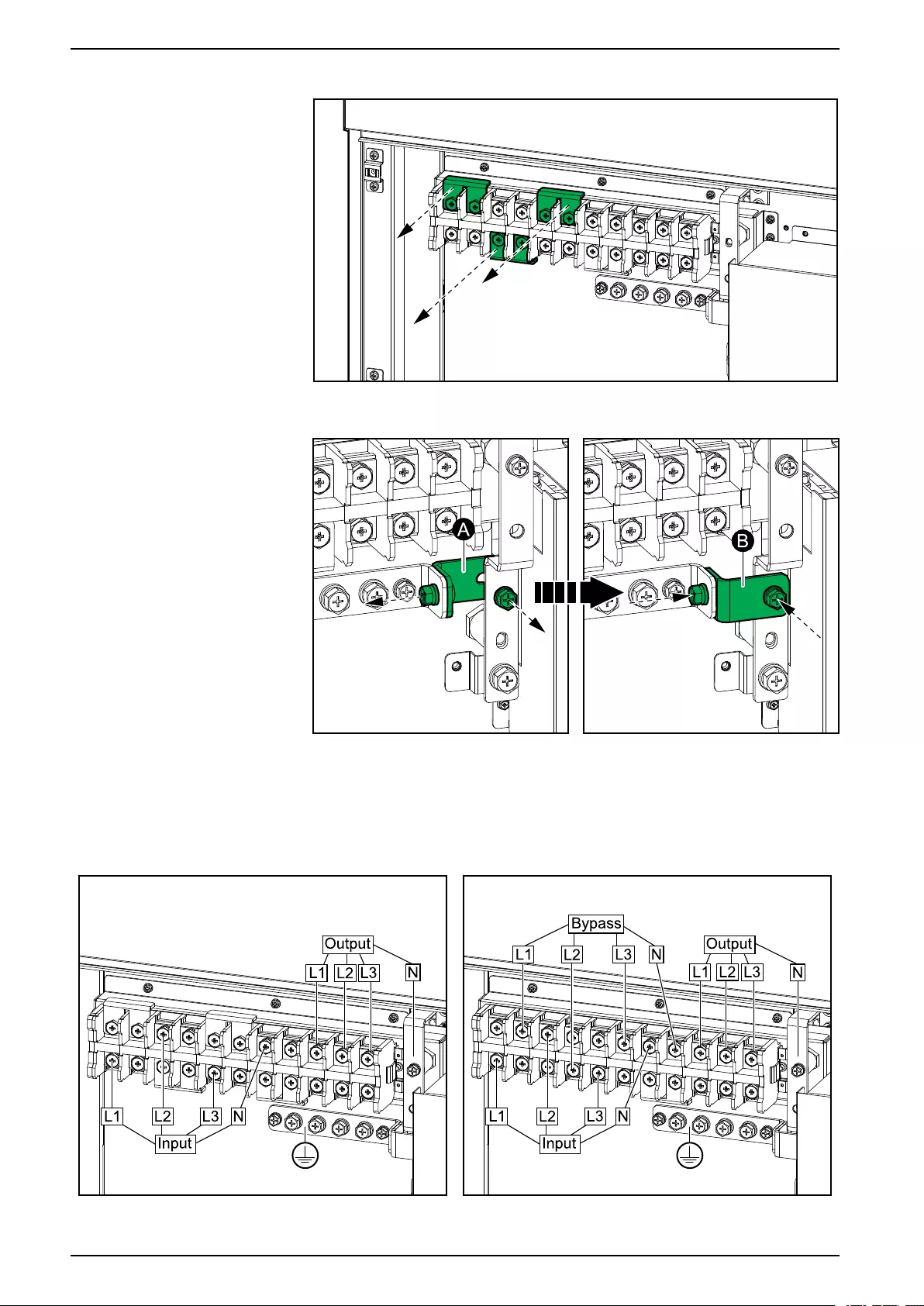
For Internal Batteries Connect the Power Cables
4. In dual mains systems, remove the three single mains brackets.
5. In TNC systems only, rotate the jumper busbar to create a connection
between the PE busbar and the neutral busbar.
6. Route the power cables through the bottom of the UPS.
7. Connect the PE cable to the PE terminal.
Single Mains System Dual Mains System
20 990-6204-001
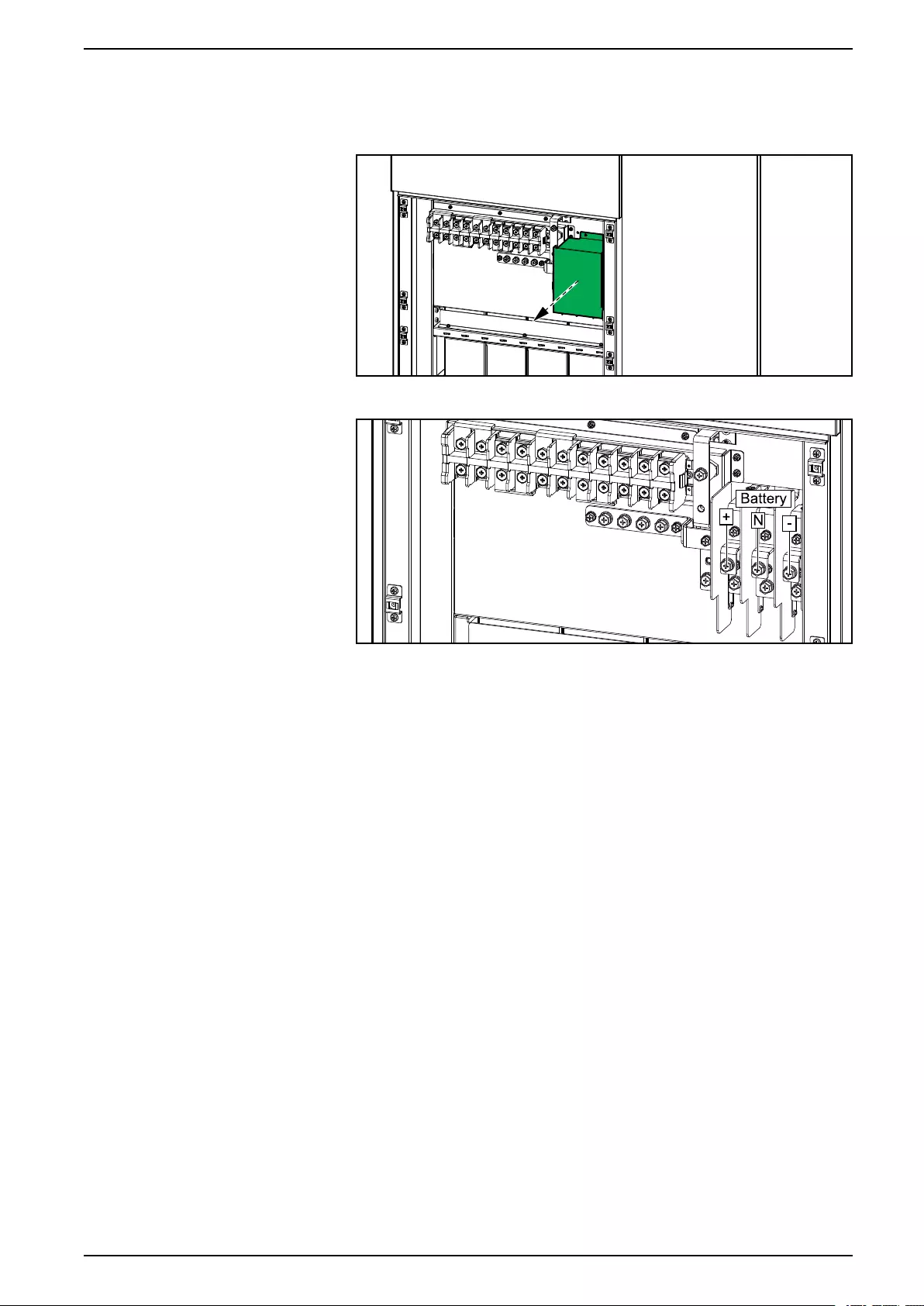
Connect the Power Cables For Internal Batteries
8. Connect the input, output, and bypass (if applicable) cables.
9. For installation with modular battery cabinets, connect the battery cables:
a. Remove the indicated cover.
b. Connect the battery cables.
c. Reinstall the cover over the battery terminals.
990-6204-001 21
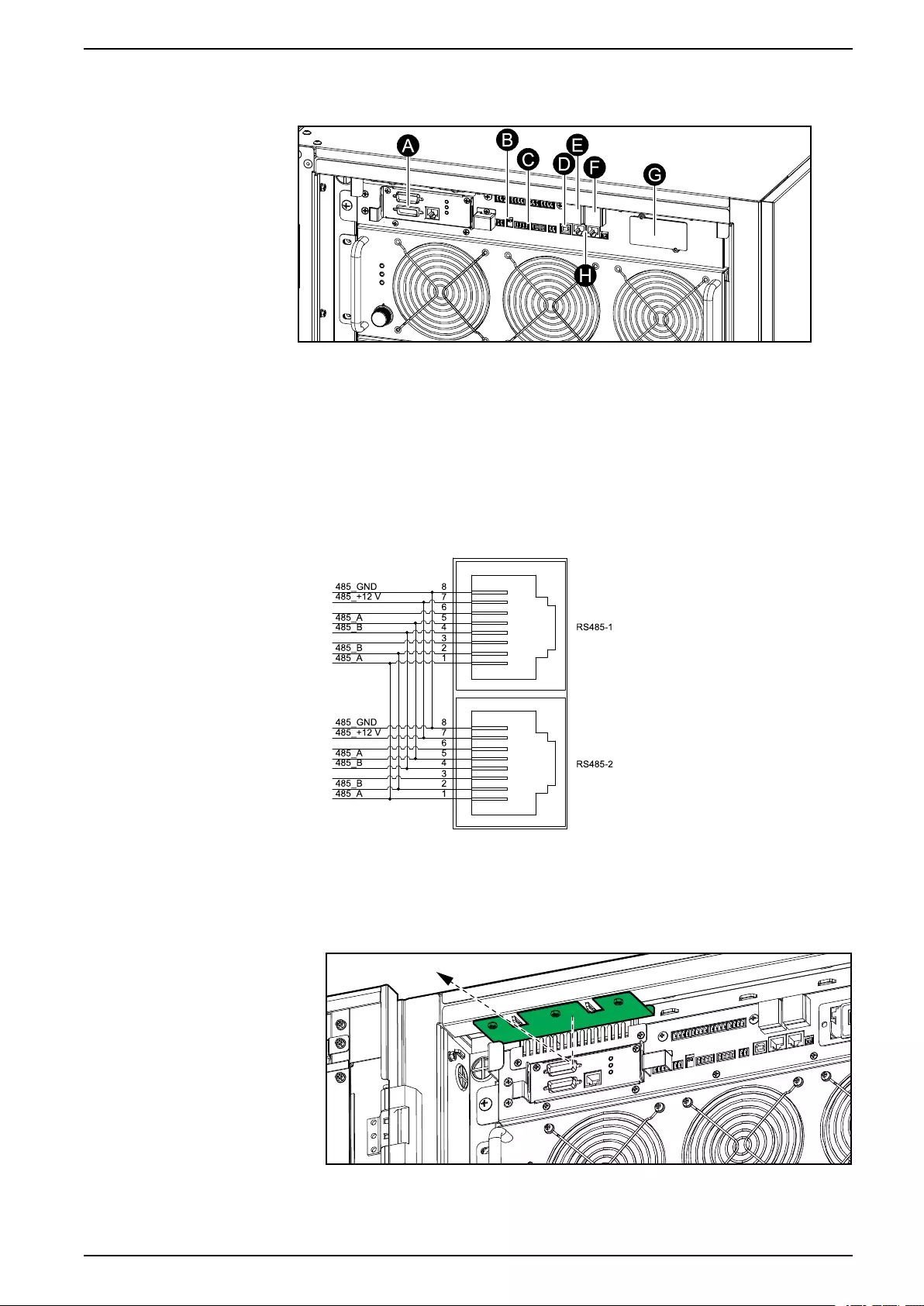
Communication Interfaces For Internal Batteries
Communication Interfaces
A. Parallel ports
B. CAN_R: CAN termination resistor
C. Dry contacts
D. USB port
E. EPO
F. Slot for optional cold start button
G. Slot for optional SNMP
H. RS485
Route the Signal Cables
1. Remove the indicated plate from the front of the UPS.
990-6204-001 23
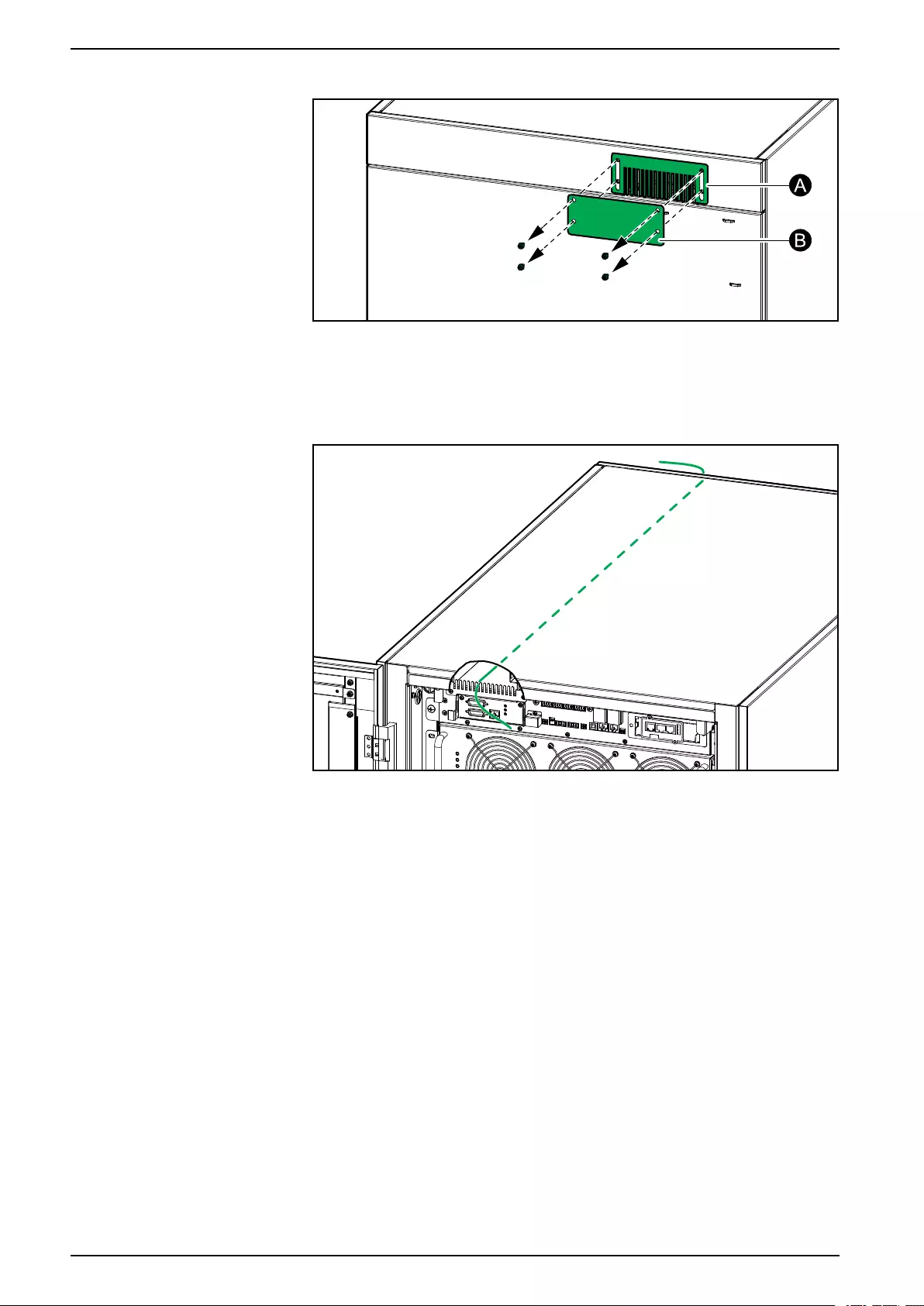
For Internal Batteries Communication Interfaces
2. Remove the rear gland plate and the rear brush plate from the UPS.
A. For installations without conduits, reinstall the brush plate.
B. For installations with conduits, drill holes for conduits and reinstall the
gland plate.
3. Route the signal cables through the gland/brush plate and to the front of the
UPS.
4. Reinstall the plate on the front of the UPS.
24 990-6204-001
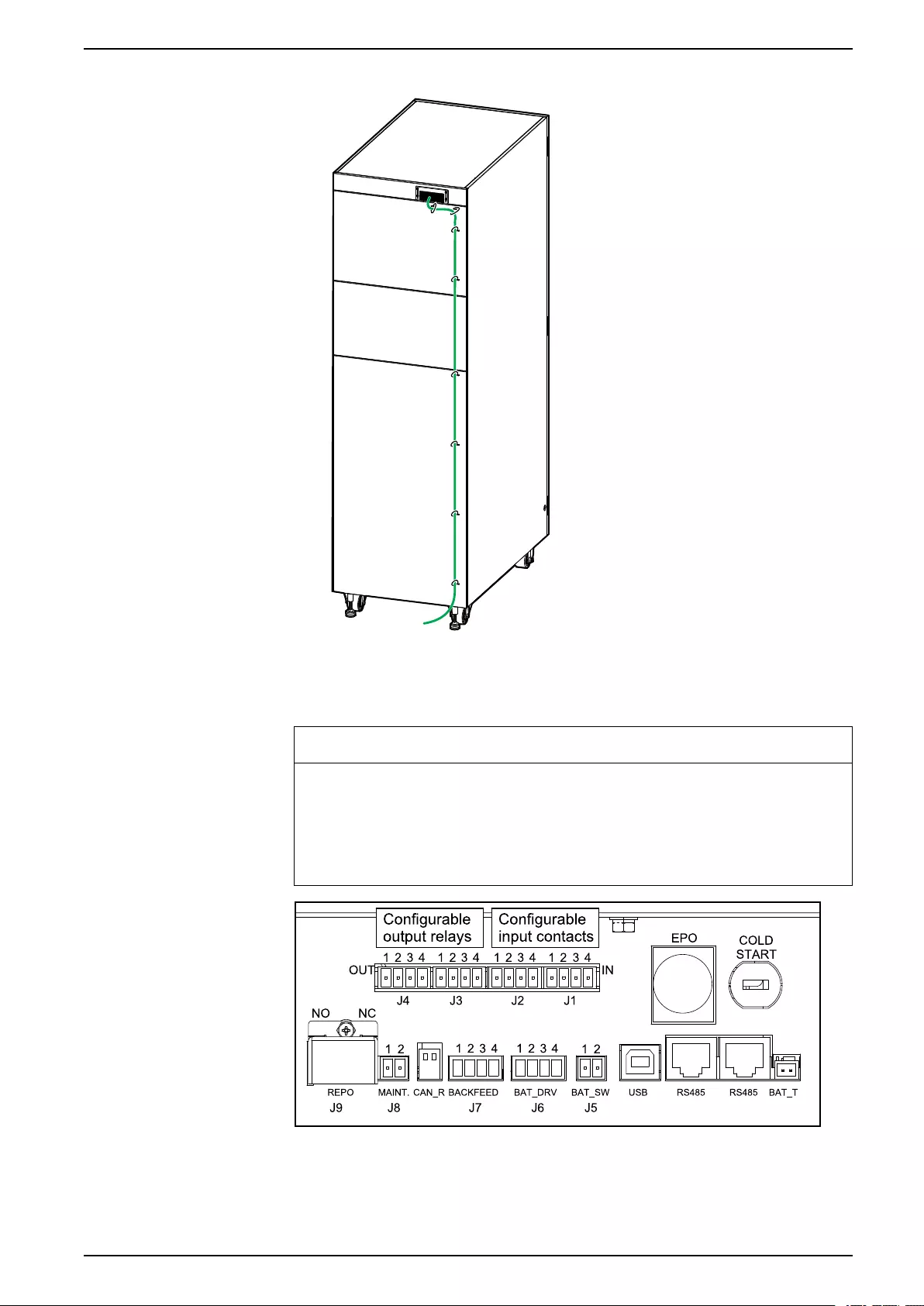
Communication Interfaces For Internal Batteries
5. Fasten the signal cables with cable ties on the rear of the UPS.
Input Contacts and Output Relays
NOTICE
RISK OF EQUIPMENT DAMAGE
The battery breaker contact drive J6–1 and J6–2 can provide a maximum of +24
VDC 400 mA to the undervoltage release coil or shunt trip release coil. If this
value is exceeded it can damage the UPS.
Failure to follow these instructions can result in equipment damage.
990-6204-001 25
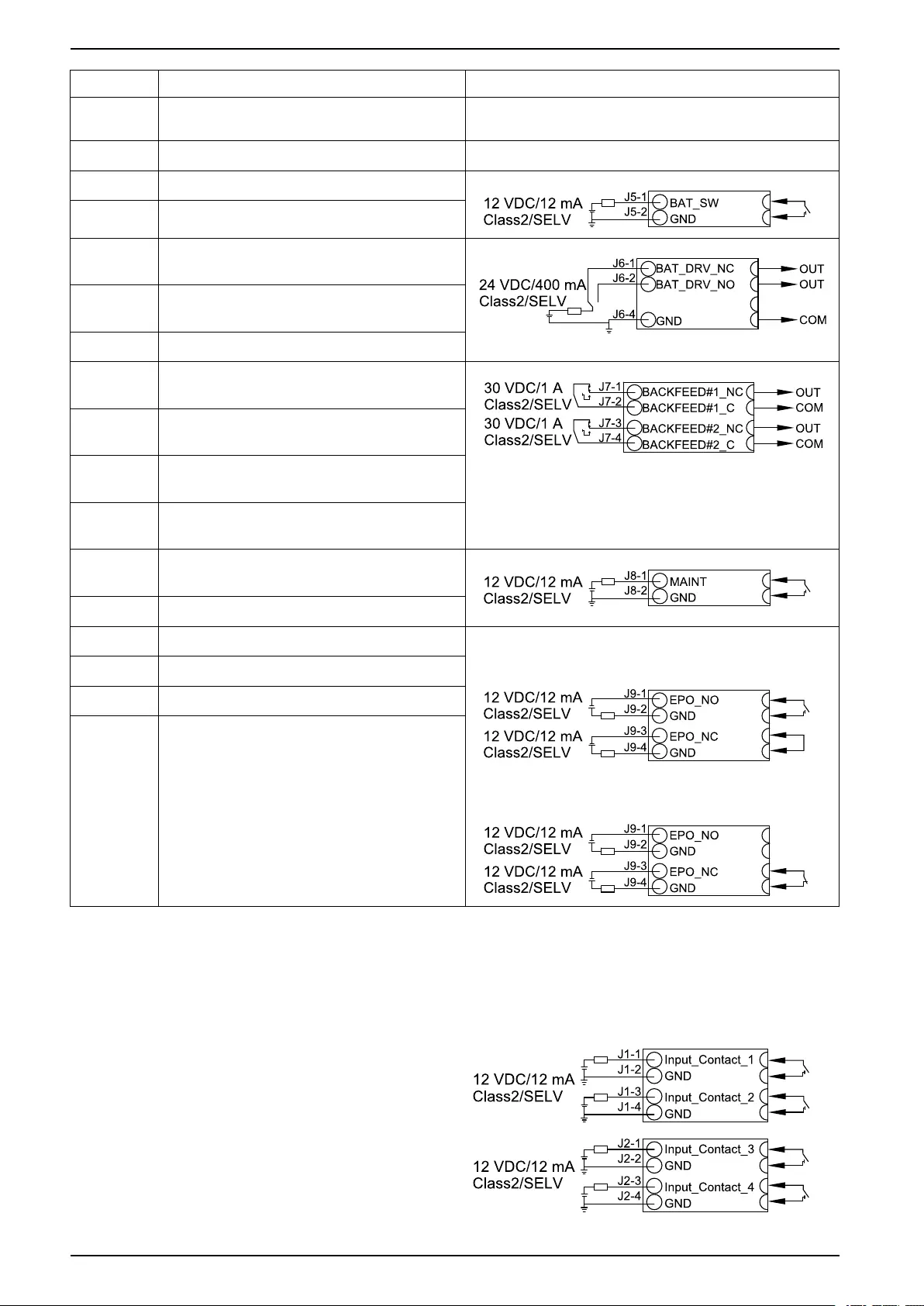
For Internal Batteries Communication Interfaces
Terminal Function
BAT_T–1 Input contact for battery temperature
sensor
BAT_T–2 Signal ground
J5–1 AUX contact for battery breaker
J5–2 Signal ground
J6–1 Normally closed output contact for battery
breaker trip
J6–2 Normally open output contact for battery
breaker trip
J6–4 Signal ground
J7–1 Backfeed 1 output relay pin 1 (normally
closed (NC) as default)
J7–2 Backfeed 1 output relay pin 2 (normally
closed (NC) as default)
J7–3 Backfeed 2 output relay pin 1 (normally
closed (NC) as default)
J7–4 Backfeed 2 output relay pin 2 (normally
closed (NC) as default)
J8–1 AUX contact for external maintenance
bypass breaker
J8–2 Signal ground
J9–1 Normally open EPO contact
NO configuration
NC configuration
J9–2 Signal ground
J9–3 Normally closed EPO contact
J9–4 Signal ground
Configurable Input Contacts
The four configurable input contacts can be configured from the display with the
following functions:
•Disable
•INV ON
•INV OFF
•Battery alarm
•Genset enable
•Custom alarm 3
•Custom alarm 4
•Disable ECO
26 990-6204-001

Communication Interfaces For Internal Batteries
Configurable Output Relays
The four configurable output contacts can be configured from the display with the
following functions:
•Disable
•Common alarm
•Normal operation
•Battery operation
•Static bypass operation
•Output overload
•Fan inoperable
•Battery alarm
•Battery disconnected
•Battery voltage low
•Input out of tolerance
•Bypass out of tolerance
•EPO activated
•Maintenance mode
•Parallel lost
990-6204-001 27
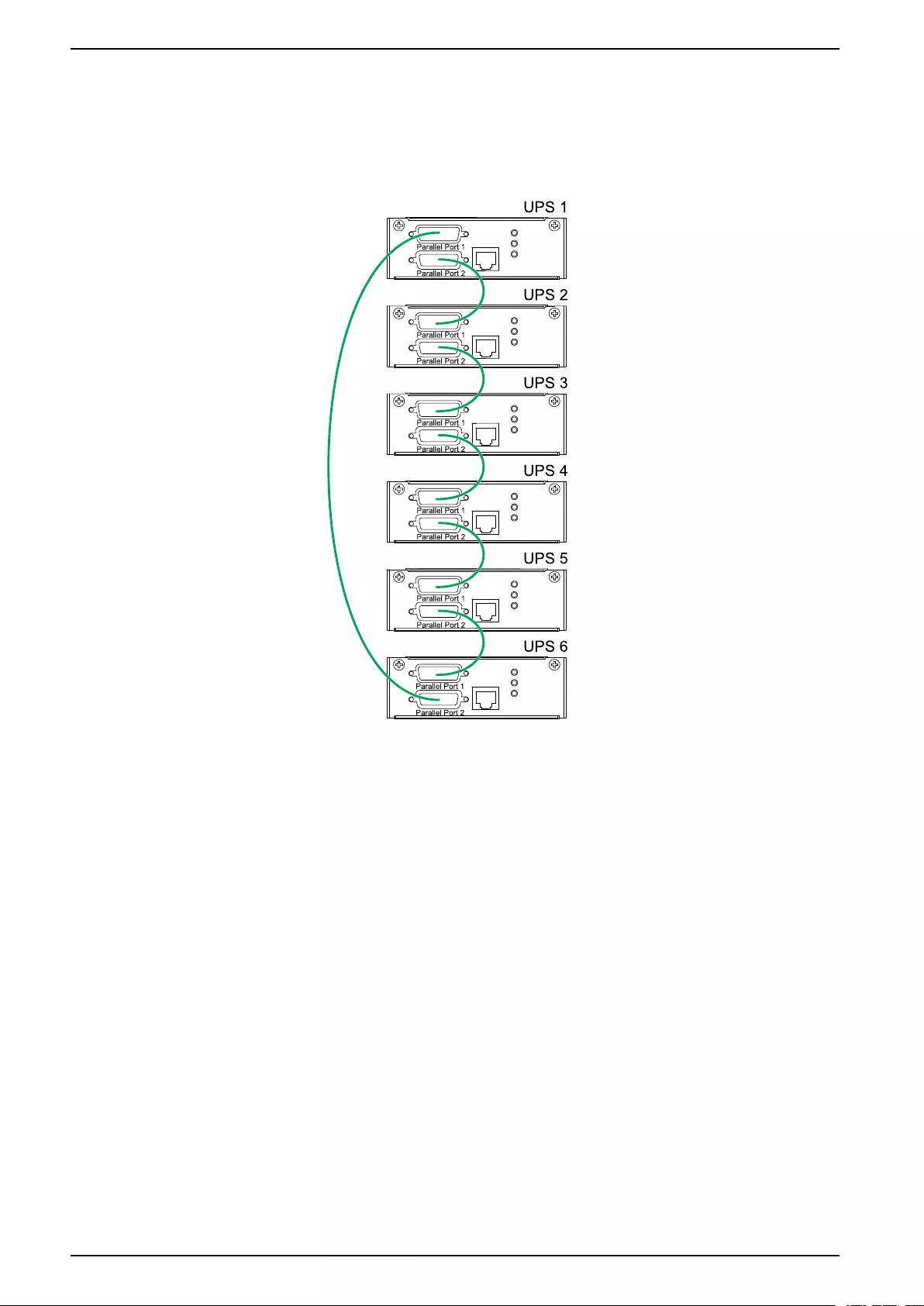
For Internal Batteries Communication Interfaces
Connect the Parallel Cables in a Parallel System
1. Connect the optional parallel cables between all the UPSs of the parallel
system.
NOTE: For location of parallel ports see Communication Interfaces, page
23.
2. Verify the setting of the CAN_R (for location of CAN_R see Communication
Interfaces, page 23).
– For parallel systems with ≤ 4 parallel UPSs, CAN_R of all UPSs must be in
ON position.
– For parallel systems with ≥ 5 parallel UPSs, CAN_R of all UPSs must be in
OFF position.
28 990-6204-001

Backfeed Protection For Internal Batteries
Backfeed Protection
DANGER
HAZARD OF ELECTRIC SHOCK, EXPLOSION, OR ARC FLASH
In systems where backfeed protection is not part of the standard design, an
automatic isolation device (backfeed protection option or other device meeting
the requirements of IEC/EN 62040–1) must be installed to prevent hazardous
voltage or energy at the input terminals of the isolation device. The device must
open within 15 seconds after the upstream power supply fails and must be rated
according to the specifications.
Failure to follow these instructions will result in death or serious injury.
When the UPS input is connected through external isolators that, when opened,
isolate the neutral or when the automatic backfeed isolation is provided external to
the equipment or is connected to an IT power distribution system, a label must be
fitted at the UPS input terminals, and on all primary power isolators installed
remote from the UPS area and on external access points between such isolators
and the UPS, by the user, displaying the following text (or equivalent in a language
which is acceptable in the country in which the UPS system is installed):
DANGER
HAZARD OF ELECTRIC SHOCK, EXPLOSION, OR ARC FLASH
Risk of Voltage Backfeed. Before working on this circuit: Isolate the UPS and
check for hazardous voltage between all terminals including the protective
earth.
Failure to follow these instructions will result in death or serious injury.
An additional external isolation device must be installed in the UPS system. A
contactor can be used for this purpose. In the shown examples, the isolation
device is a contactor (marked with a MC1 for single mains systems and marked
with a MC1 and MC2 for dual mains systems).
The isolation device must be able to withstand the electrical characteristics as
described in Specifications, page 11.
NOTE: The 24 V source should be generated from the switchgear input
source in single mains configurations and from both the switchgear input and
bypass source in dual mains configurations.
990-6204-001 29
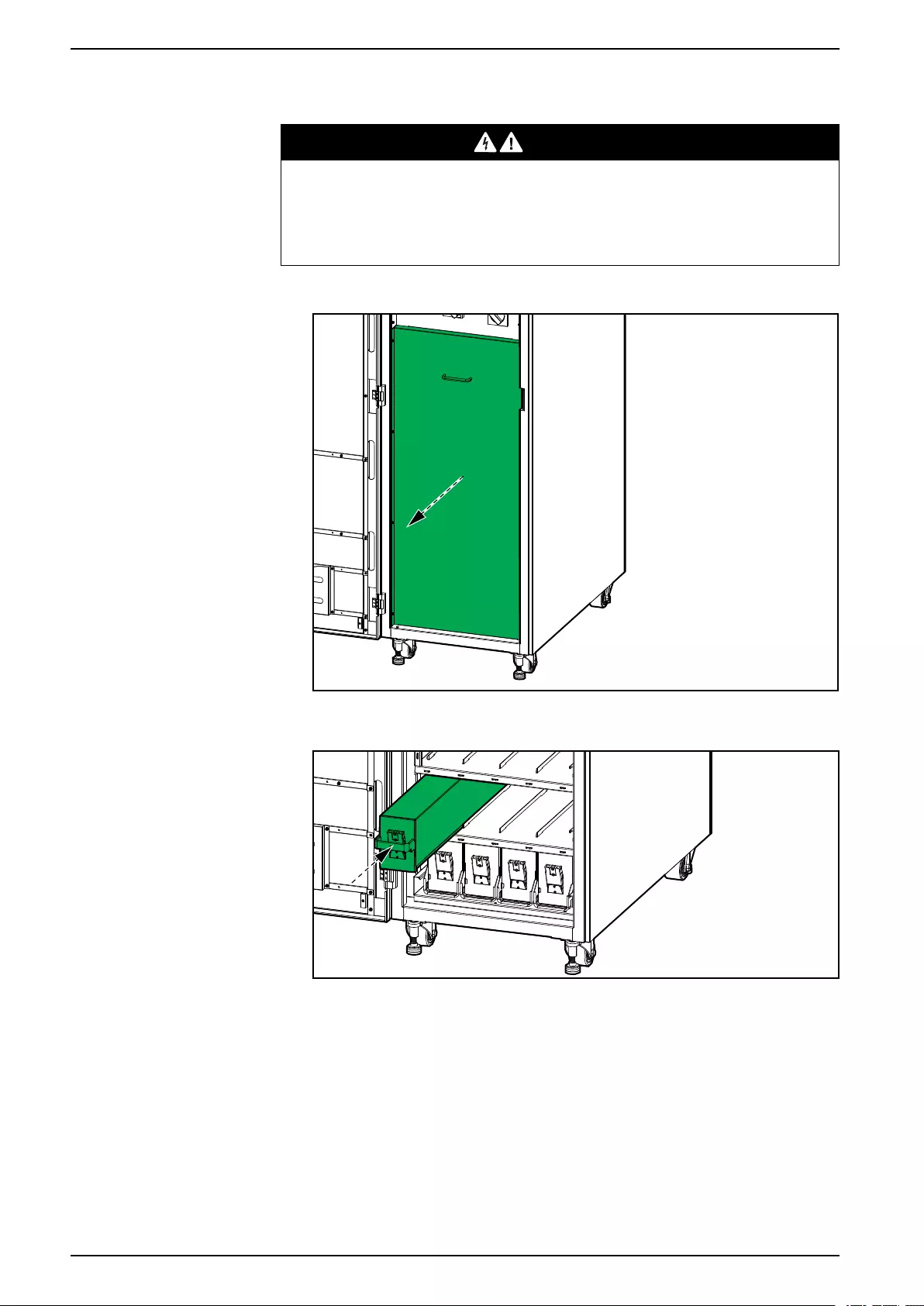
For Internal Batteries Install Batteries in the UPS
Install Batteries in the UPS
DANGER
HAZARD OF ELECTRIC SHOCK, EXPLOSION, OR ARC FLASH
Ensure that the battery breakers (BB) are in the off position before installing
batteries.
Failure to follow these instructions will result in death or serious injury.
1. Remove the plate in front of the battery shelves.
2. Install battery modules one string at a time and from the bottom and up. One
row is one battery string.
32 990-6204-001



Printed in:
Schneider Electric
35 rue Joseph Monier
92500 Rueil Malmaison - France
+ 33 (0) 1 41 29 70 00
+ 91 9886115853
Schneider Electric
35 rue Joseph Monier
92500 Rueil Malmaison
France
+ 33 (0) 1 41 29 70 00
*990-6204-001*
As standards, specifications, and design change from time to time,
please ask for confirmation of the information given in this publication.
© 2019 – 2019 Schneider Electric. All rights reserved.
990-6204-001
